In this article, we will explore seven top inventions in electronics that have shaped the industry and impacted our daily lives.
We will examine each invention in detail, highlighting its history, functions, and benefits.
The Invention of Transistors
The invention of transistors marked the beginning of the modern electronics era. Developed by Bell Labs in 1947, transistors were a significant improvement over vacuum tubes, which were bulky and unreliable.
Transistors are semiconductor devices that can amplify or switch electronic signals.
Invented in 1947 by a team of researchers at Bell Laboratories, including William Shockley, John Bardeen, and Walter Brattain. At the time, the primary electronic device was the vacuum tube, which was large, fragile, and consumed a significant amount of power.
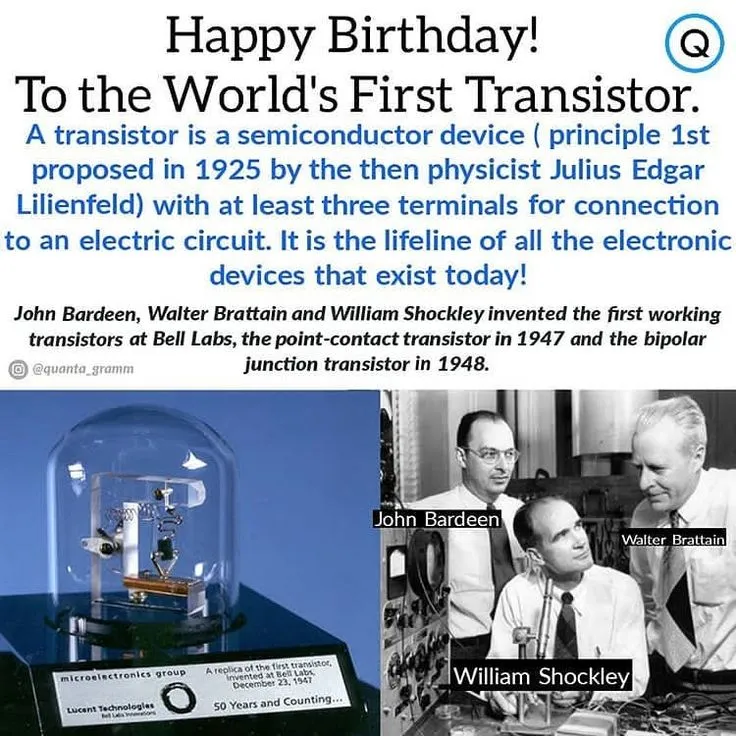
The invention of the transistor changed all of that. The transistor is a tiny solid-state component that can be used for switching and amplification. It is inexpensive to make in large quantities and is constructed of semiconductor materials like silicon.
The invention of the transistor paved the way for the development of smaller, more efficient electronic devices such as radios, TVs, and computers.
The Development of Integrated Circuits
The development of ICs revolutionized the electronics industry by allowing the creation of complex electronic circuits on a single chip. The first IC was created in 1958 by Jack Kilby of Texas Instruments and Robert Noyce of Fairchild Semiconductor.
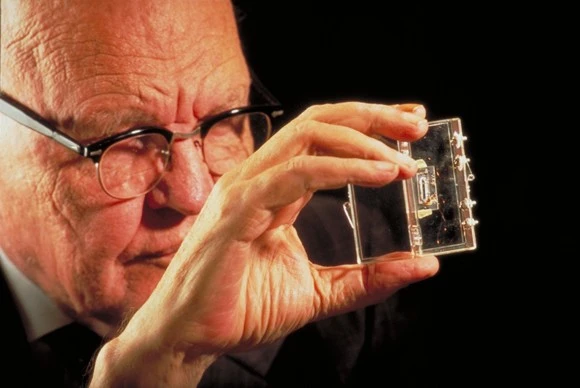
ICs made electronic devices smaller, cheaper, and more reliable. They are used in a variety of products, including calculators, computers, and mobile devices.
These are the most notorious first integrated circuit devices:
- Fairchild 903 and 904 Flip-Flops: In 1961, Fairchild Semiconductor introduced the first commercially available integrated circuits, which were simple flip-flops used in digital circuits.
- IBM System/360: The IBM System/360 mainframe computer, introduced in 1964, was the first computer to use integrated circuits extensively. It contained over 60 different types of integrated circuits, and its design allowed for easy upgrades and expansion.
- Apollo Guidance Computer: The Apollo Guidance Computer, used in the Apollo spacecraft that landed on the moon, was the first integrated circuit-based computer to be used in space. It was introduced in 1966 and used over 5,000 integrated circuits.
- Texas Instruments Pocket Calculator: In 1971, Texas Instruments introduced the first pocket calculator, the TI-2500 Datamath. It used a single-chip calculator integrated circuit and revolutionized the calculator industry.
- Intel 4004 Microprocessor: The Intel 4004, introduced in 1971, was the first microprocessor to be produced in large quantities. It contained 2,300 transistors on a single chip and was used in a variety of applications, including calculators and early personal computers.
The Creation of the Microprocessor
The creation of the microprocessor was a significant breakthrough in the electronics industry. A microprocessor is a central processing unit (CPU) that contains all the functions of a computer’s processing unit on a single chip.
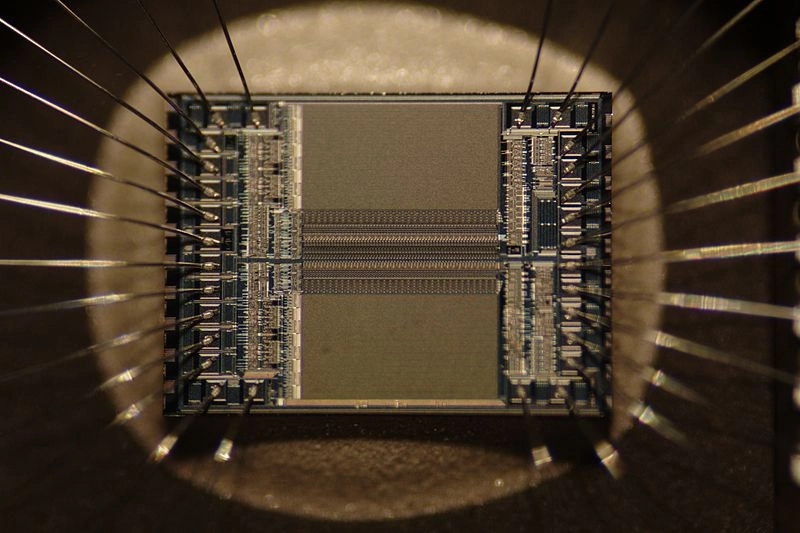
The first microprocessor, the Intel 4004, was introduced in 1971. Since then, microprocessors have become smaller, faster, and more powerful. They are used in a wide range of devices, from smartphones and tablets to cars and home appliances.
Classic microprocessors are made using a process called photolithography. It involves creating a pattern on a photoresist layer and transferring it onto a silicon wafer.
The transistors are created using a process called doping, and the circuitry is connected using metal layers and vias. This process is repeated multiple times to create the complex circuitry required for modern microprocessors.
Here is a list of the most popular first microprocessors:
- Intel 4004 – the first microprocessor ever created, introduced in 1971
- Intel 8080 – a widely used microprocessor in the 1970s and the successor to the 8008
- Motorola 6800 – a popular microprocessor in the late 1970s and early 1980s
- Zilog Z80 – a widely used microprocessor in the 1980s, especially in home computers
- Intel 8086 – the first 16-bit microprocessor, which paved the way for the modern PC architecture
- Motorola 68000 – a powerful 16/32-bit microprocessor used in early personal computers and gaming consoles
- Intel 80386 – a significant improvement over the 80286, which enabled the use of modern operating systems like Windows and Linux.
The Emergence of Liquid Crystal Displays (LCDs)
The emergence of LCDs transformed the electronics industry. It made possible the creation of thinner, lighter, and more energy-efficient displays. LCDs use liquid crystals to block or allow light to pass through, creating images on a screen.
The first LCD was created in 1971 by George Heilmeier of RCA Laboratories. Since then, LCD technology has evolved to create high-definition displays used in televisions, computers, and smartphones.
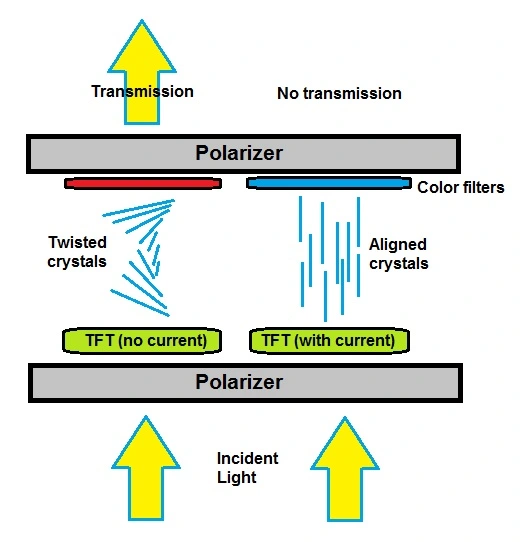
The first commercial application of LCD technology was in digital watches in the mid-1970s. These early LCDs were limited to showing only a few digits, but their low power consumption made them ideal portable devices.
One of the earliest mass-produced devices to use an LCD was the Casio Mini Calculator, which was introduced in 1972. This calculator was small enough to fit in a pocket and used a small, six-digit LCD.
Another interesting fact about LCDs is that they were not initially well-received by the public. When the first LCD televisions were introduced in the early 2000s, many complained about their poor contrast and color reproduction.
However, advances in LCD technology have since made them the dominant display technology in the television market.
Today, LCDs are used in a wide range of electronic devices, from smartphones and laptops to televisions and digital signage. They offer several advantages over other display technologies, including low power consumption, high resolution, and durability.
Despite their widespread use, LCD technology continues to evolve. New advancements in materials and manufacturing processes promise even better performance in the future.
The Advancement of Light Emitting Diodes (LEDs)
The advancement of light-emitting diodes (LEDs) has led to the creation of energy-efficient lighting solutions. LEDs are semiconductor devices that emit light when an electric current passes through them.
The first LED was created in 1962 by Nick Holonyak Jr. of General Electric. Since then, LED technology has evolved to create bright, long-lasting, and energy-efficient lighting solutions used in homes, businesses, and outdoor spaces.
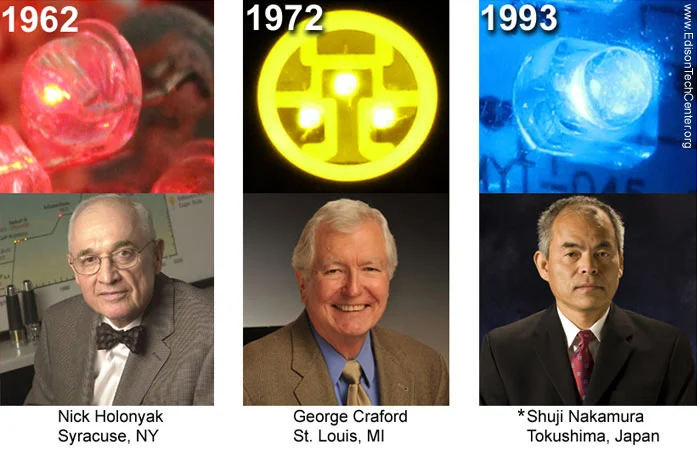
One of the main advantages of LEDs is their energy efficiency. Unlike incandescent bulbs, which produce light by heating a filament, LEDs generate light through a process called electroluminescence.
This means that they use much less energy to produce the same amount of light. This makes them perfect for home lighting to automotive and aerospace applications.
Another advantage of LEDs is their long lifespan. LED lights can last for tens of thousands of hours or more. Compared to just a few thousand hours for traditional bulbs. This means that they require less frequent replacement, which can result in significant cost savings over time.
In addition to their energy efficiency and long lifespan, LEDs offer several other benefits. They are highly durable and can withstand a wide range of environmental conditions, including extreme temperatures and humidity.
The Evolution of Touchscreens
The evolution of touch screens has transformed the way we interact with electronic devices. Touchscreens use sensors to detect the user’s touch, allowing for easy and intuitive navigation.
The first touchscreen was created in 1965 by E.A. Johnson of the Royal Radar Establishment in England. Since then, touchscreens have become ubiquitous in mobile devices, tablets, and computers.
One of the main benefits of touchscreens is their ease of use. With a touchscreen, users can simply tap or swipe their fingers on the screen to input data, navigate menus, or control the device.
This can make the user experience more intuitive and streamlined and can reduce the need for physical buttons or controls. This can make it easier to perform complex tasks or navigate through large amounts of data and can provide a more immersive and engaging user experience.
In industrial settings, touchscreens may be designed to withstand extreme temperatures, humidity, or vibration. While in healthcare settings, they may be designed to be easily cleaned and disinfected.
The Introduction of Smartphones
The introduction of smartphones has revolutionized the electronics industry by combining the functionality of a computer, camera, and media player in a single device. The first smartphone, IBM’s Simon, was introduced in 1993.
Since then, smartphones have become smaller, more powerful, and more affordable. They are now a ubiquitous part of our daily lives, allowing us to stay connected, work remotely, and access information and entertainment on the go.
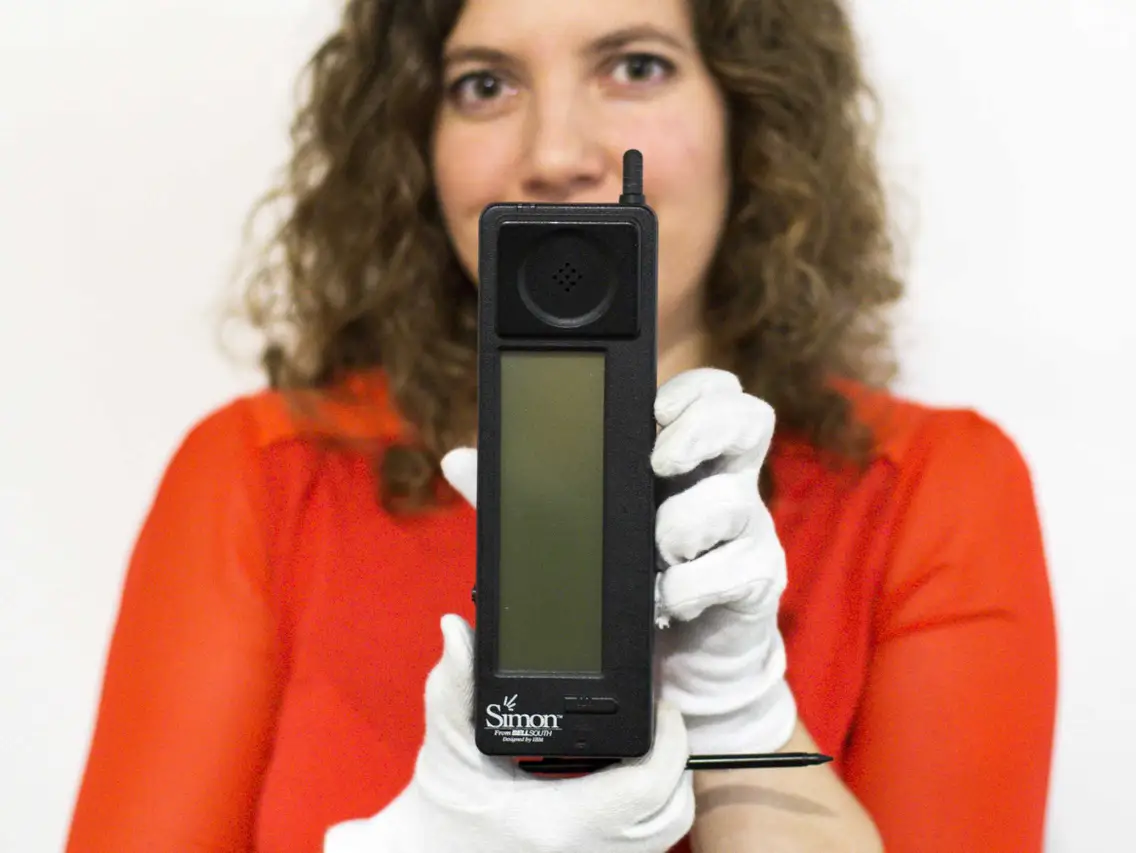
Here are listed the world’s first Smartphones:
- IBM Simon (1993): The IBM Simon is widely considered to be the world’s first smartphone. It had a touch screen, could send and receive faxes and emails and had a calendar, address book, and calculator.
- Ericsson R380 (2000): The Ericsson R380 was one of the first smartphones to run on the Symbian operating system. It had a flip-up design and a full QWERTY keyboard.
- Nokia 9210 Communicator (2000): The Nokia 9210 was a groundbreaking device that combined a mobile phone with a personal digital assistant (PDA). It had a large color screen, a full QWERTY keyboard, and could send and receive emails.
- Handspring Treo (2002): The Handspring Treo was one of the first smartphones to integrate a full QWERTY keyboard with a touch screen. It also had a built-in camera and could connect to the internet.
- BlackBerry 5810 (2002): The BlackBerry 5810 was one of the first smartphones to feature wireless email capabilities. It also had a full QWERTY keyboard and a monochrome screen.
While the revolutionary first Apple iPhone came first in 2007.
FAQs
Q. What is the most significant invention in electronics?
A. The most significant invention in electronics is subjective and depends on personal opinion. However, some of the most groundbreaking inventions include transistors, integrated circuits, microprocessors, LCDs, LEDs, touchscreens, and smartphones.
Q. What impact have these inventions had on society?
A. These inventions have transformed the way we live, work, and interact with technology. They have made electronic devices smaller, more powerful, and more affordable, allowing for widespread use in a variety of industries. They have also revolutionized the way we communicate, access information, and entertain ourselves.
Q. What are some emerging technologies in electronics?
A. Some emerging technologies in electronics include artificial intelligence, virtual and augmented reality, blockchain, and the Internet of Things (IoT). These technologies have the potential to transform industries and create new opportunities for innovation and growth.
Q. How do these inventions impact the environment?
A. Some electronic devices, particularly older models, can have negative impacts on the environment due to their energy consumption, use of toxic materials, and lack of recycling. If you’d like to learn more, here is another article about Why Sustainability Matters.
Q. What does the future of electronics look like?
A. The future of electronics is likely to include even more advanced technologies that are smaller, faster, and more powerful. This may include the continued development of AI and IoT, as well as breakthroughs in materials science and quantum computing.
Conclusion
In conclusion, the development of electronics has had a significant impact on society, transforming the way we live, work, and communicate. From the invention of transistors to the introduction of smartphones, each innovation has played a crucial role in shaping the industry and driving progress.
As we look to the future, it’s exciting to imagine the possibilities of even more advanced and sophisticated technologies that will continue to transform our world.
References:
Science | BBC Earth. (n.d.). Link
Microprocessor – Wikipedia. Link
Transistor – Wikipedia. Link





